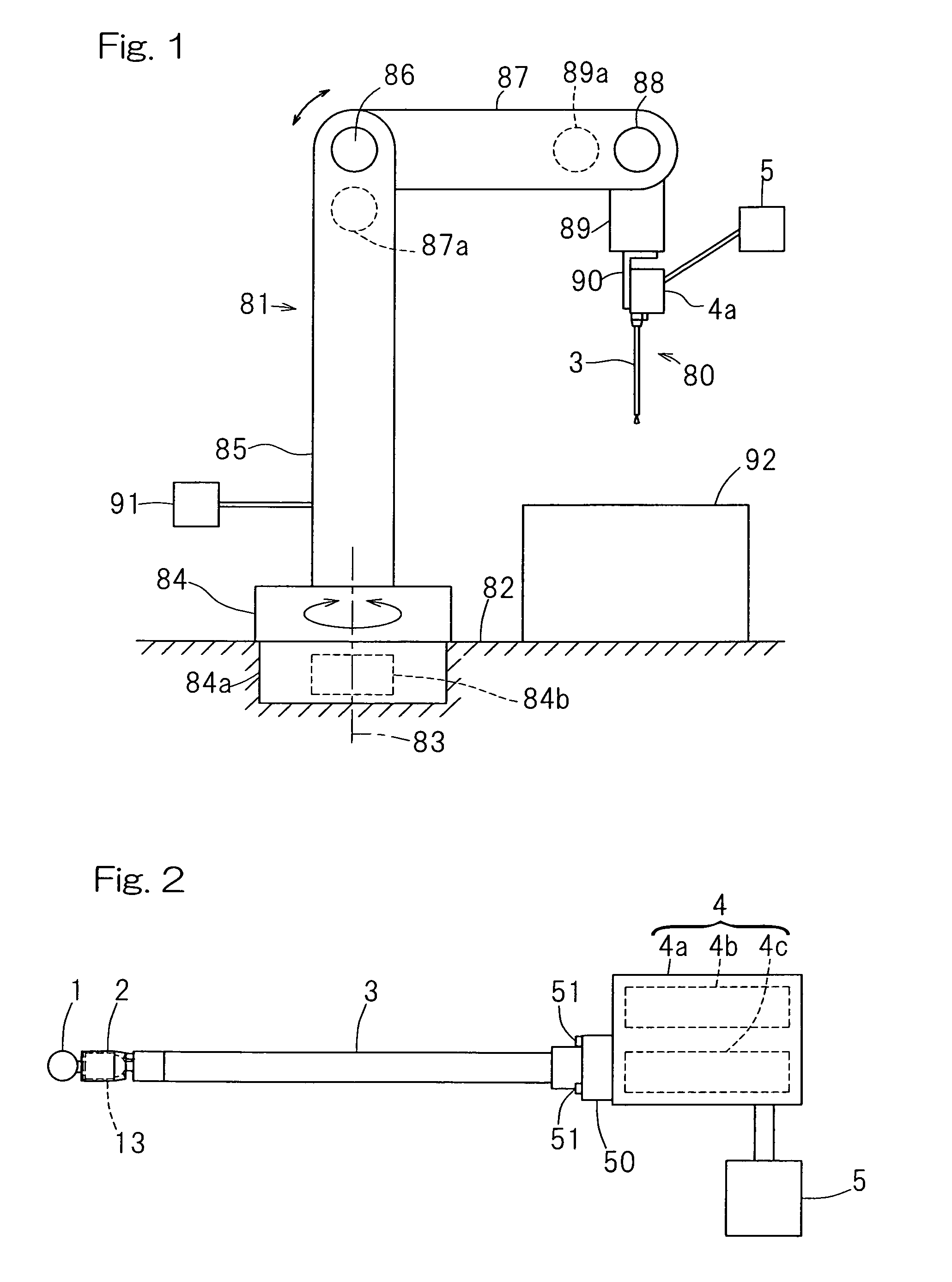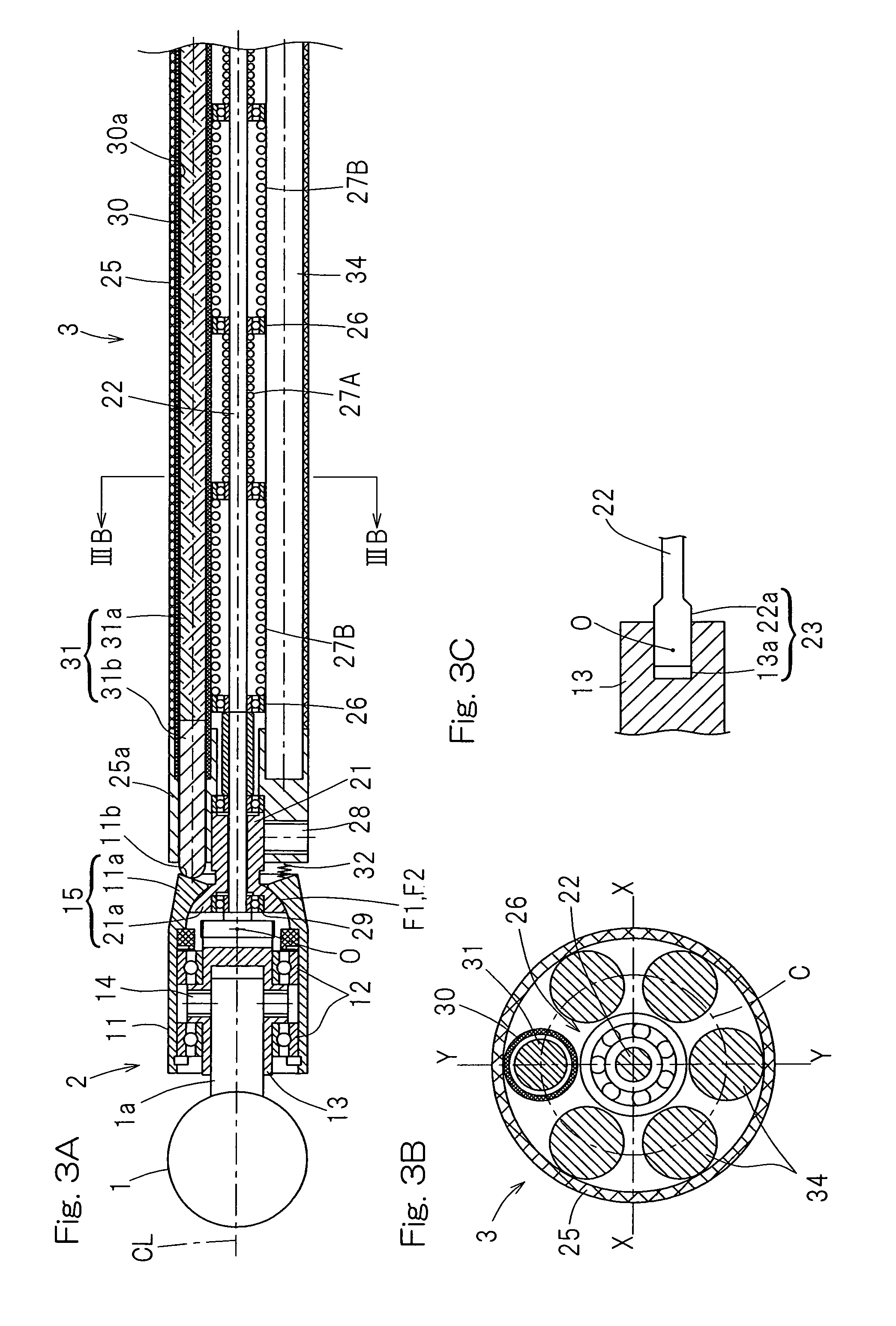Remote-controlled work robot
a robot and remote control technology, applied in the field of remote control actuators, can solve the problems of limiting the working range of the tool, the difficulty of processing the insertion opening of the artificial joint, and the considerable limitation of the disposition mechanism for changing the attitude of the tool, so as to achieve the effect of simplifying the spindle guide and reducing the diameter
- Summary
- Abstract
- Description
- Claims
- Application Information
AI Technical Summary
Benefits of technology
Problems solved by technology
Method used
Image
Examples
first embodiment
[0107]Even the remote controlled actuator 80 having the curved spindle guide section 3 is of a structure basically similar to that shown in and described with reference to FIGS. 3A to 4B in connection with the previously described first embodiment of the present invention in which the spindle guide section 3 has been shown and described as straight in shape, except for the difference in shape of the spindle guide section 3. It is, however, to be noted that where the spindle guide section 3 is of a curved shape, the outer shell pipe 25, the guide pipe 30 and the reinforcement shafts 34 have to be also curved. Also, the rotary shaft 22 is preferably made of a material easy to deform and, for example, a shape memory alloy is a suitable material for the rotary shaft 22.
[0108]FIG. 7 illustrates a third preferred embodiment of the present invention, in which the support device 81 is of a structure different from that has been described above. The support device 81 for the remote controlle...
fourth embodiment
[0109]A fourth preferred embodiment of the present invention, in which the support device 81 of a further different structure is employed, is shown in FIG. 8, reference to which will now be made. The support device 81 for the remote controlled work robot according to the present invention is made up of a three-degrees-of-freedom system 81a of a structure similar to the support device 81, shown in and described with reference to FIGS. 1 and 5, and a small sized multi-degrees-of-freedom system 81b provided in the pivot arm 89 of the three-degrees-of-freedom system 81a, and the remote controlled actuator 80 is mounted supported by the small sized multi-degrees-of-freedom system 81b through the mounting stand 90. The small sized multi-degrees-of-freedom system 81b may be any type provided that it has a plurality of degrees of freedom and is not therefore specifically limited to that shown and described. However, for the small sized multi-degrees-of-freedom system 81b, a mechanism of a h...
fifth embodiment
[0111]FIG. 9 illustrates a fifth preferred embodiment of the present invention utilizing the support device 81 of a yet different structure. The support device 81 used in the remote controlled work robot is itself of the small size multi-degrees-of-freedom system of the structure similar to the small size multi-degrees-of-freedom structure shown in and described with particular reference to FIG. 8 and, hence, the support device 81 secured to the ceiling 94, defining the base, and the remote controlled actuator 80 is supported by this support device 81 through the mounting stand 90. The support device 81, which is the small sized multi-degrees-of-freedom system, is controlled by the support device controller 98 for the small sized multi-degrees-of-freedom system. It is, however, to be noted that the support device 81 may be secured to the ceiling 94 through a suitable mounting member (not shown) instead of being secured directly to the ceiling 94. In such case, the mounting member d...
PUM
| Property | Measurement | Unit |
|---|---|---|
| bending angle | aaaaa | aaaaa |
| angle of swivel | aaaaa | aaaaa |
| arm angle | aaaaa | aaaaa |
Abstract
Description
Claims
Application Information
 Login to View More
Login to View More - R&D
- Intellectual Property
- Life Sciences
- Materials
- Tech Scout
- Unparalleled Data Quality
- Higher Quality Content
- 60% Fewer Hallucinations
Browse by: Latest US Patents, China's latest patents, Technical Efficacy Thesaurus, Application Domain, Technology Topic, Popular Technical Reports.
© 2025 PatSnap. All rights reserved.Legal|Privacy policy|Modern Slavery Act Transparency Statement|Sitemap|About US| Contact US: help@patsnap.com



